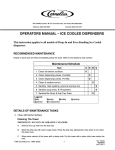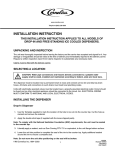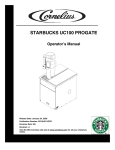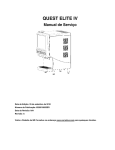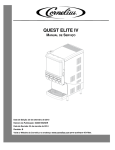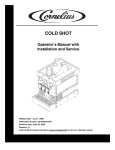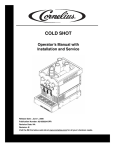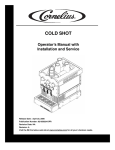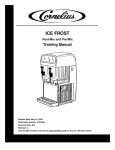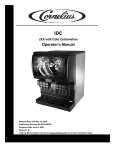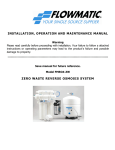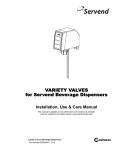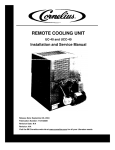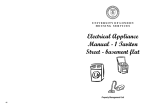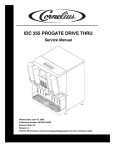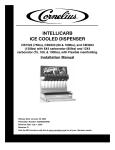Download Cornelius Ice Cooled Dispensers Technical information
Transcript
® ICE COOLED DISPENSERS Operators Manual Release Date: October 8, 2003 Publication Number: 166239002 Revision Date: July 12, 2010 Revision: B Visit the IMI Cornelius web site at www.cornelius.com for all your Literature needs. The products, technical information, and instructions contained in this manual are subject to change without notice. These instructions are not intended to cover all details or variations of the equipment, nor to provide for every possible contingency in the installation, operation or maintenance of this equipment. This manual assumes that the person(s) working on the equipment have been trained and are skilled in working with electrical, plumbing, pneumatic, and mechanical equipment. It is assumed that appropriate safety precautions are taken and that all local safety and construction requirements are being met, in addition to the information contained in this manual. This Product is warranted only as provided in Cornelius’ Commercial Warrant applicable to this Product and is subject to all of the restrictions and limitations contained in the Commercial Warranty. Cornelius will not be responsible for any repair, replacement or other service required by or loss or damage resulting from any of the following occurrences, including but not limited to, (1) other than normal and proper use and normal service conditions with respect to the Product, (2) improper voltage, (3) inadequate wiring, (4) abuse, (5) accident, (6) alteration, (7) misuse, (8) neglect, (9) unauthorized repair or the failure to utilize suitably qualified and trained persons to perform service and/or repair of the Product, (10) improper cleaning, (11) failure to follow installation, operating, cleaning or maintenance instructions, (12) use of “non-authorized” parts (i.e., parts that are not 100% compatible with the Product) which use voids the entire warranty, (13) Product parts in contact with water or the product dispensed which are adversely impacted by changes in liquid scale or chemical composition. Contact Information: To inquire about current revisions of this and other documentation or for assistance with any Cornelius product contact: www.cornelius.com 800-238-3600 Trademarks and Copyrights: Aurora, Cornelius, FlavorFusion, Hydro Boost, Optifill, Pinnacle, and Vanguard are registered trademarks of IMI Cornelius Inc. This document contains proprietary information and it may not be reproduced in any way without permission from Cornelius. Printed in U.S.A. Copyright © 2005-2010, All Rights Reserved, IMI Cornelius, Inc. Safety . . . . . . . . . . . . . . . . . . . . . . . . . . . . . . . . . . . . . . . . . . . . . . . . . . . . . . . . . . . . . . . . . . . . . . . . . . . Safety Instructions . . . . . . . . . . . . . . . . . . . . . . . . . . . . . . . . . . . . . . . . . . . . . . . . . . . . . . . . . . . . . . . Read and follow all safety instructions . . . . . . . . . . . . . . . . . . . . . . . . . . . . . . . . . . . . . . . . . . . . . Recognize safety alerts . . . . . . . . . . . . . . . . . . . . . . . . . . . . . . . . . . . . . . . . . . . . . . . . . . . . . . . . Different types of alerts . . . . . . . . . . . . . . . . . . . . . . . . . . . . . . . . . . . . . . . . . . . . . . . . . . . . . . . . Safety Tips . . . . . . . . . . . . . . . . . . . . . . . . . . . . . . . . . . . . . . . . . . . . . . . . . . . . . . . . . . . . . . . . . . . . . Qualified Service Personnel. . . . . . . . . . . . . . . . . . . . . . . . . . . . . . . . . . . . . . . . . . . . . . . . . . . . . . . . CO2 (Carbon Dioxide) Warning . . . . . . . . . . . . . . . . . . . . . . . . . . . . . . . . . . . . . . . . . . . . . . . . . . . . . Shipping And Storage . . . . . . . . . . . . . . . . . . . . . . . . . . . . . . . . . . . . . . . . . . . . . . . . . . . . . . . . . . . . Mounting in a Counter . . . . . . . . . . . . . . . . . . . . . . . . . . . . . . . . . . . . . . . . . . . . . . . . . . . . . . . . . . . . System Overview . . . . . . . . . . . . . . . . . . . . . . . . . . . . . . . . . . . . . . . . . . . . . . . . . . . . . . . . . . . . . . . . . . Recommended Maintenance . . . . . . . . . . . . . . . . . . . . . . . . . . . . . . . . . . . . . . . . . . . . . . . . . . . . . . . Details of Maintenance Tasks . . . . . . . . . . . . . . . . . . . . . . . . . . . . . . . . . . . . . . . . . . . . . . . . . . . . . . Clean All Exterior Surfaces . . . . . . . . . . . . . . . . . . . . . . . . . . . . . . . . . . . . . . . . . . . . . . . . . . . . . Cleaning the Tower . . . . . . . . . . . . . . . . . . . . . . . . . . . . . . . . . . . . . . . . . . . . . . . . . . . . . . . . Cleaning Dispensing Valves, Post-Mix . . . . . . . . . . . . . . . . . . . . . . . . . . . . . . . . . . . . . . . . . . . . Clean Dispensing Valves, Pre-Mix. . . . . . . . . . . . . . . . . . . . . . . . . . . . . . . . . . . . . . . . . . . . . . . . Clean and Sanitize Ice Bin, Drains and Drip Tray . . . . . . . . . . . . . . . . . . . . . . . . . . . . . . . . . . . . Sanitize Tank Systems, Post-Mix and Pre-Mix . . . . . . . . . . . . . . . . . . . . . . . . . . . . . . . . . . . . . . Sanitize Syrup Lines, BIB Systems . . . . . . . . . . . . . . . . . . . . . . . . . . . . . . . . . . . . . . . . . . . . . . . CO2 Settings . . . . . . . . . . . . . . . . . . . . . . . . . . . . . . . . . . . . . . . . . . . . . . . . . . . . . . . . . . . . . . . . . . . Drink Dispenser Valves . . . . . . . . . . . . . . . . . . . . . . . . . . . . . . . . . . . . . . . . . . . . . . . . . . . . . . . . . . . . . Valve Type . . . . . . . . . . . . . . . . . . . . . . . . . . . . . . . . . . . . . . . . . . . . . . . . . . . . . . . . . . . . . . . . . . . . . Troubleshooting. . . . . . . . . . . . . . . . . . . . . . . . . . . . . . . . . . . . . . . . . . . . . . . . . . . . . . . . . . . . . . . . . . . 1 1 1 1 1 1 1 1 2 2 3 3 3 3 3 4 4 4 4 5 5 7 7 8 Ice Cooled Dispensers Operators Manual SAFETY SAFETY INSTRUCTIONS Read and follow all safety instructions Read and follow all safety instructions in this guide and on the machine (decals, labels, and laminated cards). Read and understand all applicable OSHA (Occupation Safety and Health Administration) safety regulations before operating the machine. Recognize safety alerts This is the safety alert symbol. When you see it in this guide or on the machine be alert to the potential of personal injury, or damage to the machine. Different types of alerts There are three types of safety alerts: DANGER — Indicates an immediate hazardous situation which if not avoided WILL result in serious injury, death, or equipment damage. WARNING — Indicates a potentially hazardous situation which, if not avoided, COULD result in serious injury, death, or equipment damage. CAUTION — Indicates a potentially hazardous situation which, if not avoided, MAY result in minor or moderate injury or equipment damage. SAFETY TIPS • Carefully read all safety messages in this guide and safety signs on the machine. • Keep safety signs in good condition and replace missing or damaged safety signs. • Learn how to operate the machine and how to use the controls properly. • Do not let anyone operate the machine without proper training. • Keep your machine in proper working condition and do not allow unauthorized modifications to the machine. QUALIFIED SERVICE PERSONNEL WARNING — Only trained and certified electrical, plumbing and refrigeration technicians should service this unit. ALL WIRING AND PLUMBING MUST CONFORM TO NATIONAL AND LOCAL CODES. FAILURE TO COMPLY COULD RESULT IN SERIOUS INJURY, DEATH OR EQUIPMENT DAMAGE. CO2 (CARBON DIOXIDE) WARNING WARNING — CO2 Displaces Oxygen. Strict Attention must be observed in the prevention of CO2 gas leaks in the entire CO2 and soft drink system. If a CO2 gas leak is suspected, particularly in a small area, immediately ventilate the contaminated area before attempting to repair the leak. Personnel exposed to high concentration of CO2 gas will experience tremors which are followed rapidly by loss of consciousness. FAILURE TO COMPLY COULD RESULT IN SERIOUS INJURY, DEATH. © 2003-2010, IMI Cornelius Inc. -1- Publication Number: 166239002 Ice Cooled Dispensers Operators Manual SHIPPING AND STORAGE CAUTION — Before shipping, storing, or relocating the Unit, syrup systems must be sanitized and all sanitizing solution must be purged from the syrup systems. All liquids, after sanitizing, must be purged from the unit. A freezing ambient environment will cause residual sanitizing solution or water remaining inside the Unit to freeze resulting in damage to the internal components. MOUNTING IN A COUNTER WARNING - When mounting the unit in a counter top, the counter must be able to support a weight in excess of 310 lbs. to insure adequate support for the unit. FAILURE TO COMPLY COULD RESULT IN SERIOUS INJURY, DEATH OR EQUIPMENT DAMAGE. Publication Number: 166239002 -2- © 2003-2010, IMI Cornelius Inc. Ice Cooled Dispensers Operators Manual SYSTEM OVERVIEW This manual applies to all models of drop-in and free-standing ice cooled dispensers. RECOMMENDED MAINTENANCE Details of each task are listed immediately below the chart. Refer to the details by task number. Maintenance Schedule Task D W M Q O Clean all exterior surfaces Clean dispensing valves, Post-Mix O Clean dispensing valves, Pre-Mix O O Clean & sanitize ice bin Sanitize tank systems, Post-Mix and Pre-Mix S Sanitize syrup lines, BIB Systems S O Sanitize Bin Drain & Drip Tray Drain Legend: Daily Operator Weekly Monthly Quarterly Service Person DETAILS OF MAINTENANCE TASKS Clean All Exterior Surfaces Cleaning the Tower (IMPORTANT: DO NOT USE ABRASIVE CLEANSERS.) 1. Remove the cup rest from the drip tray. 2. Wash the drip tray with warm soapy water. Rinse the drip tray, allowing the rinse water to run down the drain hose. 3. Wipe entire exterior of the tower with a damp cloth. Dry the tower with a clean cloth. CAUTION: To minimize the possibility of damaging the surface of the painted tower care must be taken when choosing a cloth. The cloth must be of clean cotton with a deep nap, or equivalent. If a damp cloth is instructed to use, it must be rinsed out in clean water, the damp or the dry cloth must be manually fluffed to a softened consistency before using to wipe or polish the painted tower. 4. For the painted tower, (rather than a stainless steel tower) the painted surface may be cleaned using mild detergents or most house hold cleaners like “ Fantastik or Mr. Clean”. After cleaning, wipe entire exterior of the tower with a damp cloth. (Do not use strong soaps, abrasive cleaners or any cleaner that contains Alcohol) Dry the tower with a clean cloth. 5. The painted tower surface may be waxed after cleaning using “Simoniz” paste wax, Aero Wax or GloCoat. After applying wax, buff the surface with a clean dry cloth to a high luster finish. © 2003-2010, IMI Cornelius Inc. -3- Publication Number: 166239002 Ice Cooled Dispensers Operators Manual Cleaning Dispensing Valves, Post-Mix 1. Remove the valve cover(s) and wash in plain water. 2. Remove the nozzle and the syrup diffuser and wash the parts in plain water. IMPORTANT: When washing the dispensing valve, care must be taken not to get water on the electrical solenoid. 3. Hold an appropriate container under the dispensing valve. Being very careful not to get water on the electrical solenoid, slowly pour plain water over the dispensing valve. 4. Install the nozzle and syrup diffuser on the valve. 5. Install the valve cover(s). Clean Dispensing Valves, Pre-Mix 1. Pour clean water over the valve to rinse away any sticky residue. 2. Using a small round nylon bristle brush, clean the valve spout with plain water. 3. Dry the valve with a clean dry cloth. Clean and Sanitize Ice Bin, Drains and Drip Tray IMPORTANT: Only trained and qualified persons should perform these cleaning and sanitizing procedures. Sanitizing Solution - Household liquid bleech that contains 5.25% sodium hypochlorit concentration, (such as Hi-Lex or Chlorox). Prepare the sanitizing solution by mixing 0.5-ounces of household bleech to one gallion of potable water. This mixture must not exceed 200 PPM of chorine, allowable by the FDA. Use this mixture for all sanitizing procedures. 1. Remove all ice from the ice bin and melt any remaining ice with hot water. 2. Remove ice bin drain strainer by lifting straight up. 3. Prepare a mild detergent solution in 120oF (48.9oC) potable water. NEVER use water hotter than 120oF (48.9oC). 4. Using a nylon bristle brush (Do Not use a wire brush), clean the cold plate and the interior of the ice bin with the detergent solution. 5. Pour the remainder of the detergent solution down the drip tray and bin drains. Observe that the solution flows freely. If not, determine the cause. It may be necessary to replace the drain tubing. 6. Prepare two or more gallons of sanitizing solution. Pour half of the solution down the bin and drip tray drains. After the has completely drained, pour the remaining solution down the drains. 7. Replace the drain strainer. 8. Using a mechanical spray bottle, prepare sanitizing solution and spray the entire interior bin surfaces. Allow to air dry. Sanitize Tank Systems, Post-Mix and Pre-Mix 1. Remove all ice from the ice bin and melt any remaining ice with hot water. 2. Remove all the quick disconnects from all the tanks. 3. Prepare a mild detergent soap solution in 100oF potable water in a suitable pail or bucket. 4. Submerge all disconnects (gas and liquid) in the soap solution and then clean them using a nylon bristle brush (Do Not use a wire brush). Rinse with clean water. Publication Number: 166239002 -4- © 2003-2010, IMI Cornelius Inc. Ice Cooled Dispensers Operators Manual 5. Prepare sanitizing solution and using a mechanical spray bottle, spray the disconnects. Allow to air dry. 6. Using a clean, empty tank, prepare five gallons of sanitizing solution. Rinse the tank disconnects with approximately 9 oz. of the sanitizing solution. Close the tank. 7. Connect a gas disconnect to the tank and then apply one of the product tubes to the tank of sanitizing solution. Operate the appropriate valve until the sanitizing solution is flowing from the valve. 8. Repeat the step above, applying a different product tube each time until all tubes are filled with the sanitizing solution. 9. For post-mix valves, remove the nozzle and syrup diffuser and clean them in a mild detergent soap solution. Rinse with clean water and reassemble the nozzle and syrup diffuser to the valve. 10. For pre-mix valves, disconnect all product tubes from the tank of sanitizing solution and then open the valves to allow the pressure to be relieved. Remove the valves from the dispenser, disassemble and wash thoroughly in a mild detergent soap solution. 11. Rinse the parts in clean water, reassemble the valve and reconnect it to the dispenser. 12. Allow the sanitizing solution to remain in the tubes for the manufacturer’s recommended exposure time. 13. Discard the tank of sanitizing solution and connect the disconnects to a tank of potable water. Operate the valves until all sanitizer has been flushed from the system and only water is flowing. 14. Connect the disconnects to the appropriate product tanks and operate each valve until all water is purged from the tubing. Sanitize Syrup Lines, BIB Systems 1. Remove all ice from the ice bin and melt any remaining ice with hot water. 2. Remove all the quick disconnects from all the BIB containers. 3. Prepare a mild detergent soap solution in 100_ F potable water in a suitable pail or bucket. 4. Submerge all disconnects in the soap solution, then clean them using a nylon bristle brush (Do Not use a wire brush). Rinse with clean water. 5. Using a plastic pail, prepare approximately five gallons of sanitizing solution. 6. Rinse the BIB disconnects in the sanitizing solution. 7. Sanitizing fittings must be attached to each BIB disconnect. If these fittings are not available, the fittings from empty BIB bags can be cut from the bags and used. These fittings open the disconnect so the sanitizing solution can be drawn through the disconnect. 8. Place all the BIB disconnects into the pail of sanitizing solution. Operate all the valves until the sanitizing solution is flowing from the valve. 9. Remove the nozzle and syrup diffuser from the valve and clean them in a mild detergent soap solution. Rinse with clean potable water and reassemble the nozzle and syrup diffuser to the valve. 10. Allow the sanitizing solution to remain in the tubes for the manufacturer’s recommended exposure time. 11. Remove the sanitizing fittings from the BIB disconnects and place them in a container of potable water. Operate the valves until all the sanitizing solution has been purged from the tubing. 12. Connect the disconnects to the appropriate BIB container. Operate the valves until all water has been flushed from the system and syrup is flowing freely. CO2 SETTINGS IMPORTANT: The settings shown below are nominal settings and they may not satisfy your system. If your installer or serviceperson has indicated other pressure settings to you, please adhere to those settings. If your system is not performing to your satisfaction, call your serviceperson. DO NOT make adjustments without consulting with a qualified serviceperson. © 2003-2010, IMI Cornelius Inc. -5- Publication Number: 166239002 Ice Cooled Dispensers Operators Manual The CO2 regulators should be set as indicated in the following table: Post-Mix Regulator Pressure Setting Primary (Carbonator) 90 - 120 PSI Secondary, Sugared Syrup Tank 55 PSI Secondary, Diet Syrup Tank 8 - 12 PSI Secondary, BIB 60 PSI Pre-Mix Basic Pressure 47 PSI For each 10 ft. of horizontal tubing between tank and dispenser Add 1 PSI For each 2 ft. of elevation Add 1 PSI For each tank per flavor over 3 tanks Add 1 PSI Basic pressure shown is based on ambient temperature of 72_F. Use a Cornelius Pre-Mix slide rule for exact calculations. Publication Number: 166239002 -6- © 2003-2010, IMI Cornelius Inc. Ice Cooled Dispensers Operators Manual DRINK DISPENSER VALVES IMI Cornelius Inc. Reynosa, MX. Drink Dispensers VALVE TYPE by Manufacturer Portion Control Maximum Operating Pressure Cornelius 130 psi Lancer 100 psi Flowmatic 100 psi McCann 130 psi Push Button Maximum Operating Pressure Cornelius 130 psi Lancer 100 psi Flowmatic 100 psi McCann 130 psi Lever Type Maximum Operating Pressure Cornelius 130 psi Lancer 100 psi Flowmatic 100 psi McCann 130 psi Autofill Lever Maximum Operating Pressure Cornelius 130 psi Lancer 100 psi Flowmatic 100 psi McCann 130 psi Non-Electric Maximum Operating Pressure Cornelius 130 psi Lancer 100 psi Pre-Mix Type Cornelius © 2003-2010, IMI Cornelius Inc. Maximum Operating Pressure 130 psi -7- Publication Number: 166239002 Ice Cooled Dispensers Operators Manual TROUBLESHOOTING Trouble Probable Cause Remedy WATER-TO-SYRUP “RATIO” TOO LOW OR TOO HIGH A. Dispensing valve syrup flow regulator not properly adjusted. A. Adjust Water-to-Syrup ‘‘Ratio’’ of dispensed drink as instructed. B. CO2 gas pressure to syrup tanks insufficient to push syrup out of tank or to pump from the BIB container. B. Adjust syrup tanks secondary CO2 regulator as instructed. ADJUSTMENT OF DISPENSING VALVE SYRUP FLOW REGULATOR DOES NOT INCREASE TO DESIRED WATERTO-SYRUP ‘‘RATIO’’ A. Dispensing valve syrup flow regulator, syrup tank quick disconnect, or syrup line restricted. A. Sanitize syrup system as instructed. B. Syrup tank quick disconnects not secure. B. Secure quick disconnects. C. Syrup tanks secondary CO2 regulator out of adjustment. C. Adjust syrup tanks secondary CO2 regulator as instructed. D. No syrup supply. D. Replenish syrup supply. E. Improper syrup Baume. E. Replace syrup supply. F. F. Dirty or inoperative piston or spring in dispensing valve syrup flow regulator. Disassemble and clean dispensing valve syrup flow regulator. G. Tapered nylon washer inside tube swivel nut connector distorted from being overtightened. G. Replace nylon washer and make sure it seats properly. ADJUSTMENT OF DISPENSING VALVE SYRUP FLOW REGULATOR DOES NOT DECREASE TO DESIRED WATERTO-SYRUP ‘‘RATIO’’. A. Dirty or inoperative piston or spring in dispensing valve syrup flow regulator. A. Disassemble and clean dispensing valve syrup flow regulator. DISPENSED PRODUCT CARBONATION TOO LOW. A. Carbonator primary CO2 regulator out of adjustment for existing water conditions or temperature. A. Adjust carbonator primary CO2 regulator (Reference manual provided with carbonator). B. Air in carbonator tank. B. Vent air out of carbonator tank through relief valve. Actuate dispensing valve carbonated water lever to make carbonator pump cycle on. C. Water, oil, or dirt, in CO2 supply. C. Remove contaminated CO2. Clean CO2 system (lines, regulators, etc.) using a mild detergent. Install a clean CO2 supply. Publication Number: 166239002 -8- © 2003-2010, IMI Cornelius Inc. Ice Cooled Dispensers Operators Manual Trouble DISPENSED PRODUCT COMES OUT OF DISPENSING VALVE CLEAR BUT FOAMS IN CUP OR GLASS. Probable Cause Remedy A. Oil film or soap scum in cup or glass. A. Use clean cup or glass. B. Ice Used for finished drink is subcooled. B. Do not use ice directly from freezer. Allow ice to become ‘‘wet’’ before using. (Refer to following NOTE). NOTE: Crushed ice in the glass also causes dispensing problems. When finished drink hits sharp edges of ice, carbonation is released from dispensed drink. DISPENSED PRODUCT PRODUCES FOAM AS IT LEAVES DISPENSING VALVE. C. Carbonator CO2 regulator pressure too high for existing water conditions or temperature. C. Reduce carbonator CO2 regulator pressure setting. (Reference manual provided with carbonator). D. Syrup over-carbonated with CO2 as indicated by bubbles in inlet syrup lines leading to unit. D. Remove syrup tanks quick disconnects. Relieve tank CO2 pressure, shake tank vigorously, then relieve tank CO2 pressure as many times as necessary to remove over-carbonation. A. Dispensing valve restricted or dirty. A. Sanitize syrup system as instructed. B. Tapered nylon washer inside carbonated water line swivel nut connector distorted restricting carbonated water flow. B. Replace nylon washer. Make sure it is properly seated. C. Dirty water supply. C. Check water filter. Replace cartridge. (see NOTE) D. Warm Product - No ice in bin, bridged ice on cold plate or plugged drain. D. Replenish ice, break ice up to eliminate bridging, unplug the drain NOTE: If water supply is dirty, be sure to flush lines and carbonator completely. It may be necessary to remove lines to carbonator tank, invert tank, and flush tank and all inlet lines to remove any foreign particles or dirt. NO PRODUCT DISPENSED FROM ALL DISPENSING VALVES. © 2003-2010, IMI Cornelius Inc. A. Transformer unplugged. A. Plug in the transformer. B. No electrical power to transformer. B. Check fuse or circuit breaker. C. Disconnected dispensing valves power cord. C. Connect dispensing valves power cord. D. Disconnected or broken wiring to dispensing valves. D. Connect or replace wiring. E. Inoperative transformer. E. Replace transformer as instructed. -9- Publication Number: 166239002 Ice Cooled Dispensers Operators Manual Trouble NO PRODUCT DISPENSED FROM ONE DISPENSING VALVE. ONLY CARBONATED WATER DISPENSED. ONLY SYRUP DISPENSED. Publication Number: 166239002 Probable Cause Remedy A. Broken or disconnected wiring. A. Repair or connect wiring. B. Inoperative dispensing valve solenoid coil. B. Replace solenoid coil as instructed. C. Inoperative dispensing valve micro-switch. C. Replace micro-switch as instructed. A. Quick disconnects not secure on syrup tanks. A. Secure quick disconnects on syrup tanks. B. Out of syrup. B. Replenish syrup supply as instructed. C. BIB connectors not properly connected. C. Inspect and properly attach the connectors. D. Syrup secondary CO2 regulator not properly adjusted. D. Adjust syrup tanks secondary CO2 regulator as instructed. E. Inoperable dispensing valve. E. Repair dispensing valve. F. F. Dispensing valve syrup flow regulator not properly adjusted. Adjust dispensing valve syrup flow regulator (Water-to-Syrup ‘‘Ratio’’) as instructed. G. Dispensing valve syrup flow regulator, syrup tank quick disconnect, or syrup lines restricted. G. Sanitize syrup system as instructed. A. Plain water inlet supply line shutoff valve closed. A. Open plain water inlet supply line shutoff valve. B. Carbonator power cord unplugged from electrical outlet. B. Plug carbonator power cord into electrical outlet. C. Carbonator primary CO2 regulator not properly adjusted. C. Adjust carbonator primary CO2 regulator (Reference manual provided with carbonator). - 10 - © 2003-2010, IMI Cornelius Inc. IMI Cornelius Inc. www.cornelius.com
















